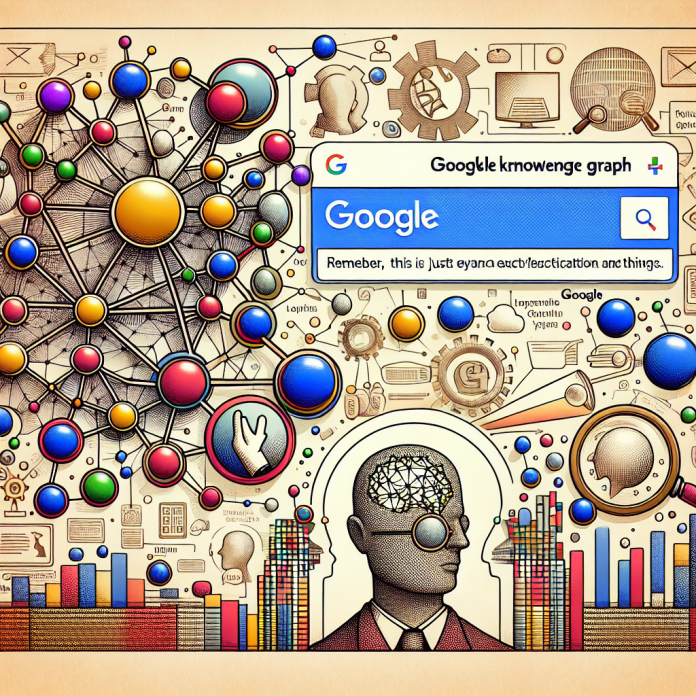Have you ever wondered how Google provides you with accurate and relevant information when you search for something? Well, let me tell you about the magnificent creation called the Google Knowledge Graph. This innovative tool is designed to enhance your search experience by understanding the context of your query and delivering more in-depth and nuanced results. With the Google Knowledge Graph, you’ll be able to unearth a wealth of knowledge and explore different aspects of your search topic effortlessly. Get ready to embark on a journey of discovery with Google’s remarkable knowledge graph!
Overview
The Google Knowledge Graph is a powerful tool that enhances search results by providing meaningful and relevant information to users. It goes beyond traditional keyword-based search algorithms by understanding the intent behind user queries and delivering comprehensive results. With the Knowledge Graph, Google aims to present users with a richer and more informative search experience.
Review contents
Definition
The Google Knowledge Graph is a knowledge base that Google has built to understand the relationships between billions of entities on the web. An entity can be a person, place, event, organization, or concept. By connecting these entities, Google creates a vast network of information that allows users to explore and discover related topics.
Purpose
The purpose of the Google Knowledge Graph is to provide users with more direct and accurate answers to their queries. Instead of presenting a list of web pages that may or may not contain relevant information, the Knowledge Graph aims to provide concise and actionable answers directly within the search results. This helps users save time and get the information they need quickly and efficiently.
Key Features
The key features of the Google Knowledge Graph include:
-
Annotations: Entities within the Knowledge Graph are annotated with additional information, such as images, descriptions, and related links, which enhance the understanding and visibility of these entities.
-
Direct answers: The Knowledge Graph strives to provide direct answers to user queries by displaying relevant information within the search results page. This eliminates the need for users to click through multiple pages to find the desired information.
-
Semantic search: The Knowledge Graph utilizes semantic search technology to understand the natural language used in search queries. This allows Google to provide more accurate and contextually relevant results.
-
Entity relationships: The Knowledge Graph maps out the relationships between entities, enabling users to explore related topics and gain a deeper understanding of the connections between different concepts.
History
Development
The development of the Google Knowledge Graph began in 2010 as an effort to improve the search experience for users. Google recognized the limitations of traditional search algorithms and saw an opportunity to provide more detailed and structured information directly within the search results page.
By analyzing patterns in user queries and incorporating semantic search technologies, Google was able to build a vast knowledge base that connects different entities on the web. This involved processing massive amounts of data and leveraging artificial intelligence to understand the relationships between entities.
Launch
The Google Knowledge Graph was officially launched in May 2012. Initially, it covered a limited number of entities, but it has since grown exponentially to include billions of entities and relationships. With each passing year, Google continues to expand and refine the Knowledge Graph, making it an integral part of the search experience for millions of users worldwide.
How It Works
Data Sources
The Google Knowledge Graph gathers information from a wide range of sources, including licensed databases, publicly available data, and user-contributed content. It also relies on structured data markup provided by website owners to extract relevant information about entities.
By combining data from various sources, Google aims to provide the most comprehensive and up-to-date information to users. This data is continuously refreshed and verified to ensure accuracy and relevance.
Knowledge Graph Entities
Entities within the Knowledge Graph are represented by nodes, each node representing an entity with its own unique identifier. These entities can be people, places, events, organizations, or concepts. The Knowledge Graph assigns attributes to these entities, such as name, description, images, and related links.
The relationships between entities are represented by edges, which connect nodes. These relationships might signify connections like “is married to,” “works at,” or “located in.” By understanding these relationships, Google can provide users with a deeper understanding of the interconnectedness of different entities.
Ranking Algorithm
The Knowledge Graph utilizes a sophisticated ranking algorithm to determine the most relevant and useful information to display in the search results. This algorithm takes into account various factors, such as the popularity and reliability of sources, the significance of the entity in popular culture, and the relevance to the user’s query.
The ranking algorithm is designed to deliver the most accurate and helpful information to users, ensuring that they receive high-quality results that directly address their queries.
Benefits
Improved Search Results
One of the major benefits of the Google Knowledge Graph is its ability to improve search results by providing direct and accurate answers to user queries. Instead of having to sift through multiple web pages, users can find the information they need right on the search results page. This saves time and frustration, making the search experience more efficient and enjoyable.
Enhanced User Experience
By presenting information directly within the search results, the Knowledge Graph enhances the overall user experience. Users no longer need to navigate through multiple websites to find the information they seek. This seamless integration of relevant information makes the search process more intuitive and user-friendly.
Semantic Search
The Knowledge Graph’s utilization of semantic search technology allows Google to better understand the intent behind user queries. This enables the search engine to provide more accurate and relevant results. Semantic search goes beyond matching keywords and takes into consideration the context and user’s intent, providing a more personalized and tailored experience for each individual user.
Applications
Answering Direct Queries
The Knowledge Graph excels at answering direct queries, such as “Who is the president of the United States?” or “When was the Eiffel Tower built?” By providing direct answers within the search results, users can quickly obtain precise information without having to click through numerous web pages.
Information Panels
Information panels, also known as knowledge panels, are a prominent feature of the Knowledge Graph. These panels appear on the right-hand side of the search results page and provide a summary of information related to a specific entity. They typically include an image, a brief description, and links to additional resources or related entities.
Voice Search
With the rising popularity of voice assistants, the Knowledge Graph plays a crucial role in providing accurate information through voice search queries. By understanding the context and intent of the spoken query, the Knowledge Graph can deliver concise answers in a conversational manner. This enhances the usability and effectiveness of voice search technology.
Personal Assistant Apps
Personal assistant apps, such as Google Assistant, rely heavily on the Knowledge Graph. These apps are designed to assist users with various tasks and answer their questions. By leveraging the vast knowledge base of the Knowledge Graph, personal assistant apps can provide detailed and relevant information to help users navigate their daily lives.
Challenges
Accuracy of Information
While the Knowledge Graph strives to provide accurate information, there are instances where errors or outdated information may be present. Gathering and verifying immense amounts of data from various sources can be a daunting task, and occasional inaccuracies may slip through the cracks. Google continuously works to improve the accuracy of the Knowledge Graph, but it remains a challenge to ensure the absolute correctness of all information presented.
Fairness and Bias
The Knowledge Graph may face challenges in maintaining fairness and avoiding bias in its presentation of information. The algorithms used to determine which entities and information are shown can inadvertently favor certain perspectives or omit others. Google actively works to address these concerns and ensure that the Knowledge Graph remains unbiased and equitable.
Data Privacy
As the Knowledge Graph relies on gathering information from various sources, data privacy concerns arise. Google takes privacy seriously and follows strict guidelines when collecting and storing data. However, the use of user-contributed content and public data may raise privacy concerns for some individuals. Google continues to prioritize user privacy and takes steps to protect sensitive information.
Criticism
Dominance of Google
One criticism of the Knowledge Graph is the potential for Google to dominate the presentation of information. As the primary search engine used by the majority of internet users, Google has significant control over the information displayed within the Knowledge Graph. This concentration of power can potentially limit the visibility and exposure of alternative viewpoints and sources.
Monopoly Concerns
Google’s dominant position in the search market has led some to express concerns about the company’s monopoly. The Knowledge Graph consolidates information from various sources, potentially giving Google unparalleled control over the information landscape. This concentration of power could stifle competition and limit user access to diverse sources of information.
Manipulation of Information
Due to the influence of the Knowledge Graph on search results, there have been concerns about the potential for information manipulation. Critics argue that Google has the ability to shape public opinion by prioritizing certain entities or perspectives in the Knowledge Graph. Google actively works to prevent manipulation and ensures that the Knowledge Graph remains a reliable source of information.
Future Developments
Expanding Knowledge Graph Coverage
Google is continually working to expand the coverage of the Knowledge Graph. As new entities and relationships are discovered and documented on the web, Google seeks to incorporate them into the Knowledge Graph. This ongoing expansion aims to provide users with a more comprehensive and interconnected understanding of the world.
Improving Accuracy and Relevance
Google remains committed to improving the accuracy and relevance of the information presented within the Knowledge Graph. Through advancements in artificial intelligence and machine learning, Google aims to enhance the understanding and interpretation of user queries, resulting in more precise and helpful answers.
Integration with AI and Machine Learning
The future of the Knowledge Graph lies in its integration with artificial intelligence and machine learning technologies. By leveraging these advanced technologies, Google can further refine the understanding of user intent and deliver even more personalized and contextually relevant results. This integration will enable the Knowledge Graph to adapt and evolve to meet the ever-changing needs of users.
Comparison
Google Knowledge Graph vs. Traditional Search
The Google Knowledge Graph differs from traditional search in its ability to provide direct answers within the search results page. Traditional search algorithms rely on keyword matching and provide users with a list of web pages that may or may not contain relevant information. The Knowledge Graph, on the other hand, leverages semantic search and entity relationships to deliver concise and targeted answers, enhancing the search experience.
Google Knowledge Graph vs. Other Knowledge Graphs
While Google’s Knowledge Graph is one of the most prominent knowledge graphs, other companies and organizations have also developed their own versions. Each knowledge graph has its own unique data sources and algorithms, providing varying levels of coverage and accuracy. The competition among these knowledge graphs benefits users by offering multiple perspectives and sources of information.
Conclusion
The Google Knowledge Graph has revolutionized the way users interact with search results by providing direct and accurate answers to their queries. With its comprehensive coverage, semantic search capabilities, and enhanced user experience, the Knowledge Graph has become an essential tool for millions of users worldwide. While challenges and criticisms exist, Google continues to work towards expanding and refining the Knowledge Graph to meet the evolving needs of users and maintain its position as a leader in the field of search technology.



























